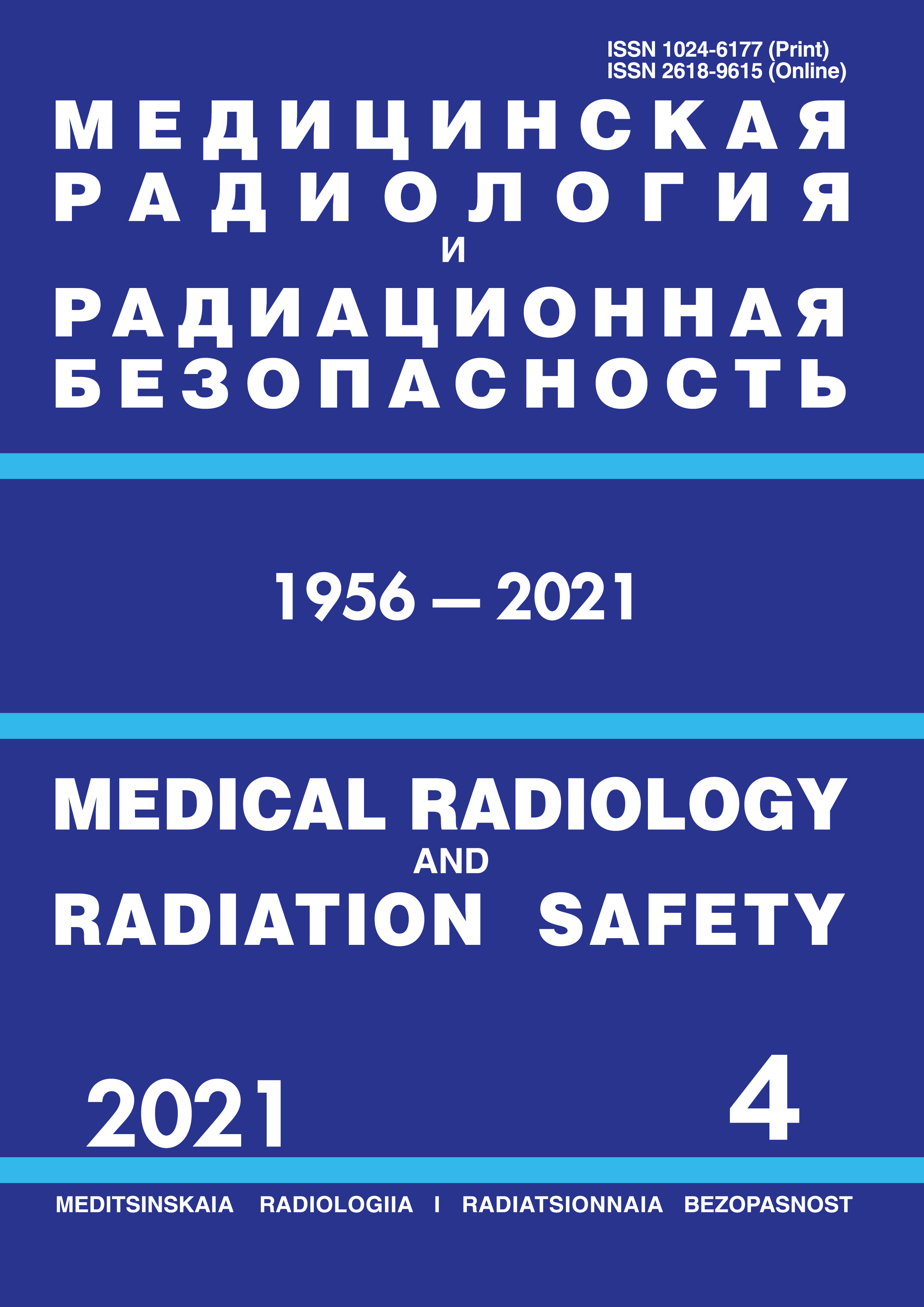Russian Federation
Peoples’ Friendship University of Russia (RUDN University), Moscow, Russia
GRNTI 76.33 Гигиена и эпидемиология
GRNTI 76.03 Медико-биологические дисциплины
OKSO 31.06.2001 Клиническая медицина
OKSO 31.08.08 Радиология
OKSO 32.08.12 Эпидемиология
OKSO 14.04.02 Ядерные физика и технологии
BBK 534 Общая диагностика
BBK 51 Социальная гигиена и организация здравоохранения. Гигиена. Эпидемиология
TBK 5712 Медицинская биология. Гистология
TBK 5734 Медицинская радиология и рентгенология
TBK 6212 Радиоактивные элементы и изотопы. Радиохимия
TBK 5708 Гигиена и санитария. Эпидемиология. Медицинская экология
Modern radioecological studies to assess the effect of natural radiation on the human body have shown that at the moment of development of society, the main contribution to the exposure of the population is made by natural sources of ionizing radiation, while from 50 to 90 % of the dose load are caused by the gas radon-222 (222Rn) and daughter products of its decay. This paper presents the results of radiation-hygienic monitoring of the potentially radon-hazardous territory of the city of Baley, Trans-Baikal Territory. The measurement of the volumetric activity of radon (OARn) was carried out in the premises of residential and public buildings by the integral method using track exposure meters REI-4. According to the indicator of the equivalent equilibrium volumetric activity of radon (EROARn), a radiation-hygienic assessment of the premises and the calculation of potential dose loads on the population living in this territory were carried out. Studies have shown that OARn in residential and public buildings depends on the geological characteristics of the territory, on the design and design of buildings and structures, and on the building materials used. It was found that the main criterion for assessing the potential radon hazard of territories is the value of OARn in rooms on the 1st floors of buildings. According to the degree of potential radon hazard, the territory of the city of Baley can be conditionally divided into 3 types: 1 type – the territory located on a geological fault; Type 2 – the southern part of the city, represented by sedimentary rocks; Type 3 – the northern part of the city, represented by rocks of the basic gabbroid group with a low content of natural radionuclides. The types of buildings and structures and the type of building materials affect the dose load, but do not determine it.
radon-222, volumetric activity, EEVA, potential radon hazard of territories, categorization of territories, residential and public buildings, nuclear legacy objects
1. UNSCEAR, 2008. Sources and Effects of Ionizing Radiation. UNSCEAR Report to the General Assembly United Nations: Vol. 1, Annex B, New York: United Nations Scientific Committee on the Effects of Atomic Radiation.
2. Zhukovskiy M.V. Radonovaya bezopasnost' zdaniy. Ekaterinburg: UrO RAN, 2000.
3. Gulabyanc L.A. / Posobie po proektirovaniyu protivoradonovoy zaschity zhilyh i obschestvennyh zdaniy. M.: NO «FEN-NAUKA», 2013.
4. Marennyy A.M., Capalov A.A., Miklyaev P.S., Petrova T.B. Zakonomernosti formirovaniya radonovogo polya v geologicheskoy srede. M.: Pero, 2016.
5. Stamat I.P., Kormanovskaya T.A., Gorskiy G.A. Radiacionnaya bezopasnost' naseleniya Rossii pri obluchenii prirodnymi istochnikami ioniziruyuschego izlucheniya: sovremennoe sostoyanie, napravleniya razvitiya i optimizacii. // Radiacionnaya gigiena. 2014, T. 7, №. 1. S. 54-62.
6. Marennyy A.M. Problema oblucheniya naseleniya ot prirodnyh istochnikov ioniziruyuschih izlucheniy. // Yadernaya i radiacionnaya bezopasnost' Rossii. 2002, T. 2, №. 5. S. 6-63.
7. Gubin A. T., Marennyy A. M., Sakovich V. A., Astafurov V.I., Nefedov N.A., Penezev A.V. Obsledovanie territoriy, obsluzhivaemyh FMBA Rossii, na soderzhanie radona v pomescheniyah. // Medicina ekstremal'nyh situaciy. 2012, T. 4, №. 42. S. 77-88.
8. Marennyy A.M., Romanov V.V., Astafurov V.I., Gubin A.T., Kiselev S.M., Nefedov N.A., Penezev A.V. Provedenie obsledovaniy zdaniy razlichnogo naznacheniya na soderzhanie radona na territoriyah, obsluzhivaemyh FMBA Rossii. // Radiacionnaya gigiena. 2015, T. 8. №. 1. S. 23-29.
9. Capalov A.A. // Principy radonovogo kontrolya v pomescheniyah zdaniy // ANRI, 2014. №.1. S. 6-15.
10. Marennyy A.M. Metodicheskie aspekty izmereniy sredney ob'emnoy aktivnosti radona v pomescheniyah integral'nym trekovym metodom // ANRI, 2012. №. 4. S. 13-19
11. MVI 2.6.1.003-99. «Radon. Izmerenie ob'emnoy aktivnosti integral'nym trekovym metodom v proizvodstvennyh, zhilyh i obschestvennyh pomescheniyah»; MI «Radon. Izmerenie ob'emnoy aktivnosti v vozduhe pomescheniy integral'nym trekovym metodom», Svidetel'stvo ob attestacii № 40090.2I385 ot 16.07.2012.
12. Normy radiacionnoy bezopasnosti (NRB-99/2009): Sanitarno-epidemiologicheskie pravila i normativy (SanPiN 2.6.1.2523-09) utv. i vvedeny v deystvie ot 07.07.09 g. - Federal'nyy centr gigieny i epidemiologii Rospotrebnadzora, 2009. 100 s.
13. MU 2.6.1. 037 - 2015. Opredelenie srednegodovyh znacheniy EROA izotopov radona v vozduhe pomescheniy po rezul'tatam izmereniy raznoy dlitel'nosti. M.: FMBA Rossii, 2016.
14. MU 2.4.1.1088-02. Ocenka individual'nyh effektivnyh doz oblucheniya naseleniya za schet prirodnyh istochnikov ioniziruyuschego izlucheniya. M.: Minzdrav Rossii; 2002.
15. Pticyn A.B. Problemy osvoeniya tehnogennyh mestorozhdeniy Zabaykal'ya. // Geologiya i mineral'no-syr'evye resursy Sibiri. 2014. №. 3. S. 128-130.
16. Venevskaya N.N. K voprosu ob ekologicheskoy situacii goroda Baley (Zabaykal'skiy kray) // Trudy XX Mezhdunarodnogo simpoziuma imeni akademika Usova M.A. studentov i molodyh uchenyh, posvyaschennogo 120-letiyu so dnya osnovaniya Tomskogo politehnicheskogo universiteta. Tomsk. 2016. 109-110 c.
17. Abramov B.N., Epova E.S., Manzyrev D.V. Geoekologicheskie problemy otrabotki rudnyh mestorozhdeniy zolota v vostochnom Zabaykal'e. Geografiya i prirodnye resursy. 2019. №. 2. S. 103-111.
18. MR 11-2/206-09. Vyborochnoe obsledovanie zhilyh zdaniy dlya ocenki doz oblucheniya naseleniya. 2000; N 11-2/206-09.
19. Arbuzov S.I. Geohimiya radioaktivnyh elementov: uchebnoe posobie // Nacional'nyy issledovatel'skiy Tomskiy politehnicheskiy universitet, Tomsk 2010.
20. Vserossiyskiy nauchno-issledovatel'skiy geologicheskiy institut im. A.P. Kaprinskogo. Katalog rastrov. Available at: http://webmapget.vsegei.ru/index.html





